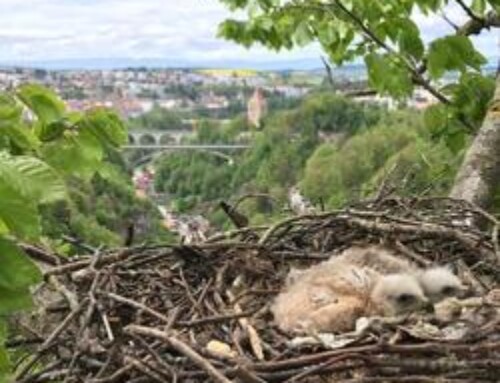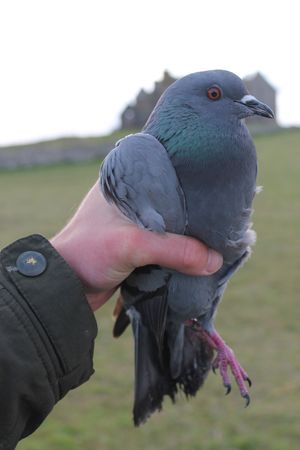 LINKED PAPER
LINKED PAPER
Limited domestic introgression in a final refuge of the wild pigeon. Smith, W.J., Sendell-Price, A.T., Fayet, A.L., Schweizer, T.M., Jezierski, M.T., van de Kerkhof, C., Sheldon, B.C., Ruegg, K.C., Kelly, S., Turnbull, L.A., Clegg, S.M. 2022 iScience. doi: 10.1016/j.isci.2022.104620 VIEW
Most British and Irish birdwatchers and ornithologists are aware that there are ‘Rock Doves’ (or ‘wild pigeons’) (Columba livia) present along the Atlantic coast of our countries. Perhaps fewer of us have given these birds much thought. In July, we published a paper, entitled ‘Limited domestic introgression in a final refuge of the wild pigeon’, in the journal iScience, which will hopefully begin to change this. Whilst people have sometimes wondered whether our Rock Dove populations are truly representative of the undomesticated pigeon lineage, there had previously been no genomic studies attempting to resolve the issue.
Human transportation of animals and plants across the world is known to cause multiple ecological issues, resulting from predation, competition, and the spread of pathogenic disease. A lesser-known impact occurs when interbreeding of closely related forms or species leads to genetic homogenisation and the replacement of the rarer form with its introduced relative. This process has been referred to as ‘extinction by hybridisation’, and has led to the Scottish Wildcat (Felis silvestris) being declared ‘functionally extinct’, the loss of the endemic Seychelles subspecies of the Malagasy Turtle Dove (Nesoenas picturatus), and the designation of the Lesser Antillean Iguana (Iguana delicatissima) as ‘Critically Endangered’. In each situation, a more common relative was introduced and began to hybridise with the native form.
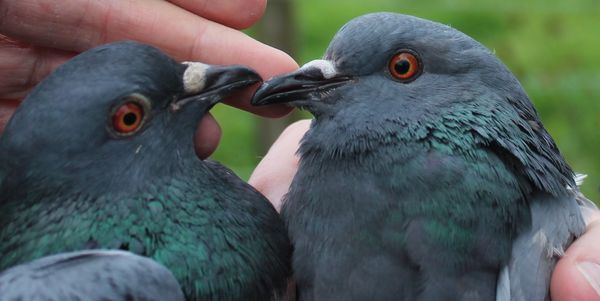
Figure 1 A feral domestic pigeon (left) and a Rock Dove (right) caught in a mixed flock on the island of Mull in the Inner Hebrides. You can see the different head shapes of the two birds. The Rock Dove has a smaller cere, thinner bill and more pronounced forehead than the feral pigeon © Will Smith.
The feral pigeon has existed for hundreds of years, and originated from escaped domestic birds kept for meat. The domestic birds themselves descended from wild Rock Doves, which were common in rocky habitats across Africa, Europe and Asia. Over the centuries, feral pigeon colonies have been supplemented by escaped domestic pigeons, and lost racing birds can still be found joining urban flocks and raising chicks with feral partners. As humans have moved around, so have our pigeons (which used to be an important source of food). In fact, feral pigeons are now present across the entire world in suitable habitats – meaning that they encounter their wild cousins, the Rock Doves. This has been bad news for the latter, and they have been gradually replaced across large chunks of their original geographic distribution. For example, in England and Wales, even in suitable cliffside habitats, only feral pigeons are present, and the nearest presumed Rock Doves are now present in western Ireland and northwest Scotland. The word ‘presumed’ is important here – because there was previously very limited evidence that these birds were: a) Actually representative of the ancestral lineage, and b) Not experiencing massive gene flow from feral pigeons. We aimed to resolve both issues in our paper.
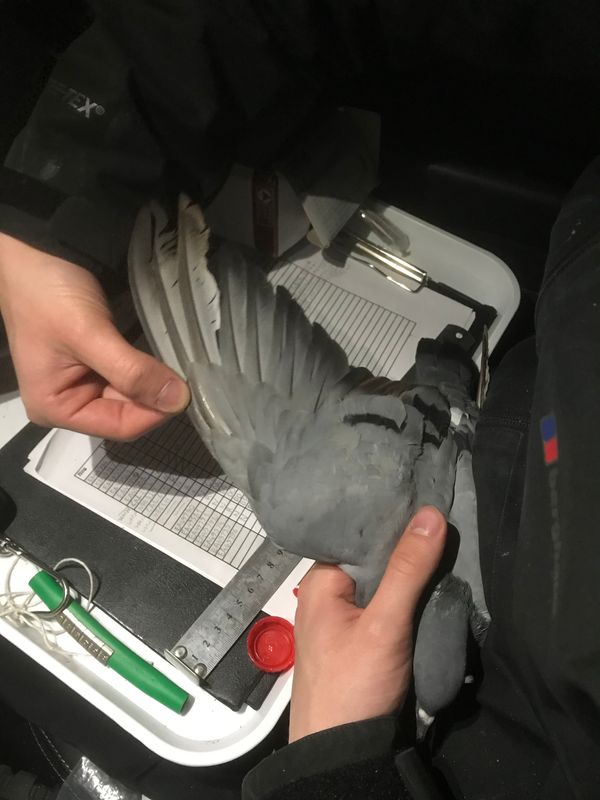
Figure 2 A Rock Dove from the relatively isolated population on South Uist, caught at a roost site in an abandoned house. This bird is being measured and having its moult progress recorded, after being ringed and DNA sampled as part of this research project. All Rock Doves were caught and handled under British Trust for Ornithology licences © Will Smith.
We used DNA sequence data from 232 birds, including a variety of domestic pigeon breeds, feral pigeons from England, Scotland and the US, and presumed Rock Doves from various parts of Scotland and Ireland. All birds were caught under licences granted by the British Trust for Ornithology and Natural England, and processed using approved ringing techniques. We used a variety of genomic analyses to explore genetic differentiation, gene flow dynamics and ancestry in order to resolve the complex genetic status of British and Irish Rock Doves. First of all, we showed that the Rock Doves form an outgroup in a phylogenetic tree with respect to all sampled domestic and feral pigeons, including very ancient breeds from the Middle East. Although the extent to which modern British and Irish Rock Doves are similar to the original wild populations that were domesticated is up for debate given that domestication first happened thousands of years ago in the Middle East, it is clear that they are an ancient genetic lineage, representing the wild form of our contemporary feral and domestic pigeons. After establishing this, we explored variation in the extent of gene flow that has happened between feral domestic pigeons and each wild Rock Dove population. We discovered that, although some populations (such as some in Orkney) have been interbreeding extensively with feral birds, and are now potentially lost as distinct lineages, others (notably those in the Outer Hebrides) have mostly escaped feral contact.
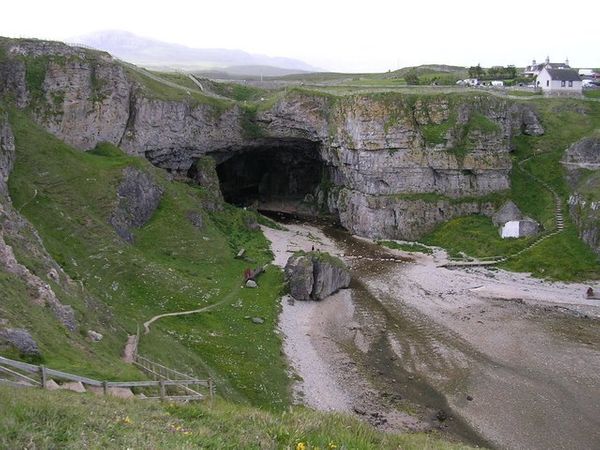
Figure 3 Smoo Cave, on the coast of north Sutherland, is home to a group of Rock Doves. Even here, far from urbanised regions, there are genetic signs of increased feral pigeon influence. Rock Dove populations on islands are generally less exposed to such gene flow © Dr E H Mackay (CC BY-SA 2.0) Wikimedia Commons.
As well as our genomic work, we took various body measurements and characterised morphological differences between the wild and feral pigeons. Wild Rock Doves have a smaller cere, thinner bill and more pronounced forehead than their cousins of domestic origin. This is useful because the two forms have often been treated together in local, national (and continental…) bird reports and ornithological literature. This means that population trends in the rarer Rock Dove will be obscured by those of the feral pigeon. Now that we have identified genetic and morphological differences between the two, we hope that work studying the Rock Dove can be carried out more easily. It’s rare to have the opportunity to study the wild form of a domestic animal, so it should enable work exploring the phenomena of domestication and feralisation, which are both important in an increasingly anthropogenic world.
References
Johnston, R., Causey, D., Johnson, S. 1988. European populations of the rock dove Columba livia and genotypic extinction. American Midland Naturalist 120: 1-10. VIEW
Smith, W.J., Quilodrán, C.S., Jezierski, M.T., Sendell‐Price, A.T., Clegg, S.M. 2022. The wild ancestors of domestic animals as a neglected and threatened component of biodiversity. Conservation Biology 36: e13867. VIEW
Rhymer, J.M., Simberloff, D. 1996. Extinction by hybridization and introgression. Annual Review of Ecology and Systematics 27: 83-109. VIEW
Redford, K. & Dudley, N. 2018. Why should we save the wild relatives of domesticated animals? Oryx 52: 397-398. VIEW
Johnston, R.F. 1992. Evolution in the rock dove: skeletal morphology. The Auk 109: 530-542. VIEW
Image credit
Top right: Rock Dove Columba livia © Will Smith.
If you want to write about your research in #theBOUblog, then please see here.



